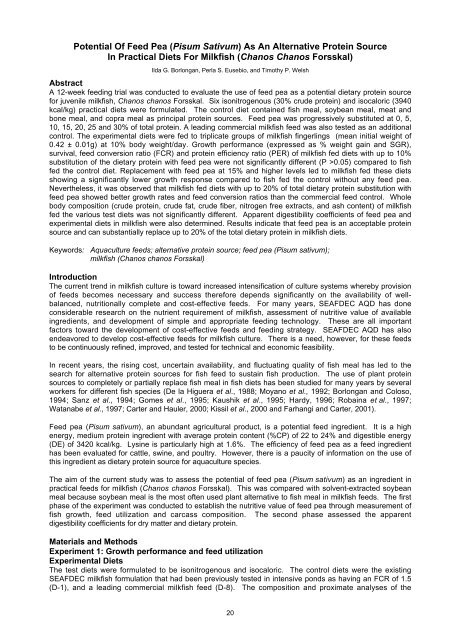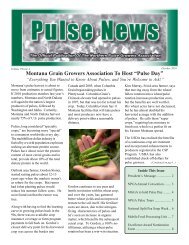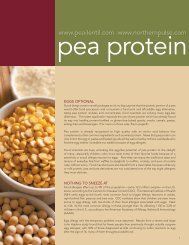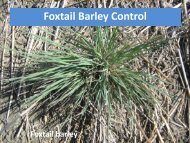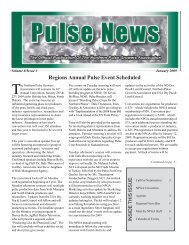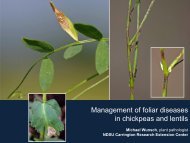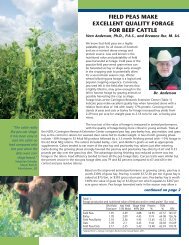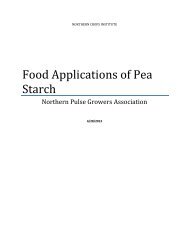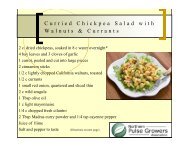Feed Peas in diets for shrimp tilapia and milkfish - Northern Pulse ...
Feed Peas in diets for shrimp tilapia and milkfish - Northern Pulse ...
Feed Peas in diets for shrimp tilapia and milkfish - Northern Pulse ...
Create successful ePaper yourself
Turn your PDF publications into a flip-book with our unique Google optimized e-Paper software.
Potential Of <strong>Feed</strong> Pea (Pisum Sativum) As An Alternative Prote<strong>in</strong> SourceIn Practical Diets For Milkfish (Chanos Chanos Forsskal)Ilda G. Borlongan, Perla S. Eusebio, <strong>and</strong> Timothy P. WelshAbstractA 12-week feed<strong>in</strong>g trial was conducted to evaluate the use of feed pea as a potential dietary prote<strong>in</strong> source<strong>for</strong> juvenile <strong>milkfish</strong>, Chanos chanos Forsskal. Six isonitrogenous (30% crude prote<strong>in</strong>) <strong>and</strong> isocaloric (3940kcal/kg) practical <strong>diets</strong> were <strong>for</strong>mulated. The control diet conta<strong>in</strong>ed fish meal, soybean meal, meat <strong>and</strong>bone meal, <strong>and</strong> copra meal as pr<strong>in</strong>cipal prote<strong>in</strong> sources. <strong>Feed</strong> pea was progressively substituted at 0, 5,10, 15, 20, 25 <strong>and</strong> 30% of total prote<strong>in</strong>. A lead<strong>in</strong>g commercial <strong>milkfish</strong> feed was also tested as an additionalcontrol. The experimental <strong>diets</strong> were fed to triplicate groups of <strong>milkfish</strong> f<strong>in</strong>gerl<strong>in</strong>gs (mean <strong>in</strong>itial weight of0.42 ± 0.01g) at 10% body weight/day. Growth per<strong>for</strong>mance (expressed as % weight ga<strong>in</strong> <strong>and</strong> SGR),survival, feed conversion ratio (FCR) <strong>and</strong> prote<strong>in</strong> efficiency ratio (PER) of <strong>milkfish</strong> fed <strong>diets</strong> with up to 10%substitution of the dietary prote<strong>in</strong> with feed pea were not significantly different (P >0.05) compared to fishfed the control diet. Replacement with feed pea at 15% <strong>and</strong> higher levels led to <strong>milkfish</strong> fed these <strong>diets</strong>show<strong>in</strong>g a significantly lower growth response compared to fish fed the control without any feed pea.Nevertheless, it was observed that <strong>milkfish</strong> fed <strong>diets</strong> with up to 20% of total dietary prote<strong>in</strong> substitution withfeed pea showed better growth rates <strong>and</strong> feed conversion ratios than the commercial feed control. Wholebody composition (crude prote<strong>in</strong>, crude fat, crude fiber, nitrogen free extracts, <strong>and</strong> ash content) of <strong>milkfish</strong>fed the various test <strong>diets</strong> was not significantly different. Apparent digestibility coefficients of feed pea <strong>and</strong>experimental <strong>diets</strong> <strong>in</strong> <strong>milkfish</strong> were also determ<strong>in</strong>ed. Results <strong>in</strong>dicate that feed pea is an acceptable prote<strong>in</strong>source <strong>and</strong> can substantially replace up to 20% of the total dietary prote<strong>in</strong> <strong>in</strong> <strong>milkfish</strong> <strong>diets</strong>.Keywords:Aquaculture feeds; alternative prote<strong>in</strong> source; feed pea (Pisum sativum);<strong>milkfish</strong> (Chanos chanos Forsskal)IntroductionThe current trend <strong>in</strong> <strong>milkfish</strong> culture is toward <strong>in</strong>creased <strong>in</strong>tensification of culture systems whereby provisionof feeds becomes necessary <strong>and</strong> success there<strong>for</strong>e depends significantly on the availability of wellbalanced,nutritionally complete <strong>and</strong> cost-effective feeds. For many years, SEAFDEC AQD has doneconsiderable research on the nutrient requirement of <strong>milkfish</strong>, assessment of nutritive value of available<strong>in</strong>gredients, <strong>and</strong> development of simple <strong>and</strong> appropriate feed<strong>in</strong>g technology. These are all importantfactors toward the development of cost-effective feeds <strong>and</strong> feed<strong>in</strong>g strategy. SEAFDEC AQD has alsoendeavored to develop cost-effective feeds <strong>for</strong> <strong>milkfish</strong> culture. There is a need, however, <strong>for</strong> these feedsto be cont<strong>in</strong>uously ref<strong>in</strong>ed, improved, <strong>and</strong> tested <strong>for</strong> technical <strong>and</strong> economic feasibility.In recent years, the ris<strong>in</strong>g cost, uncerta<strong>in</strong> availability, <strong>and</strong> fluctuat<strong>in</strong>g quality of fish meal has led to thesearch <strong>for</strong> alternative prote<strong>in</strong> sources <strong>for</strong> fish feed to susta<strong>in</strong> fish production. The use of plant prote<strong>in</strong>sources to completely or partially replace fish meal <strong>in</strong> fish <strong>diets</strong> has been studied <strong>for</strong> many years by severalworkers <strong>for</strong> different fish species (De la Higuera et al., 1988; Moyano et al., 1992; Borlongan <strong>and</strong> Coloso,1994; Sanz et al., 1994; Gomes et al., 1995; Kaushik et al., 1995; Hardy, 1996; Roba<strong>in</strong>a et al., 1997;Watanabe et al., 1997; Carter <strong>and</strong> Hauler, 2000; Kissil et al., 2000 <strong>and</strong> Farhangi <strong>and</strong> Carter, 2001).<strong>Feed</strong> pea (Pisum sativum), an abundant agricultural product, is a potential feed <strong>in</strong>gredient. It is a highenergy, medium prote<strong>in</strong> <strong>in</strong>gredient with average prote<strong>in</strong> content (%CP) of 22 to 24% <strong>and</strong> digestible energy(DE) of 3420 kcal/kg. Lys<strong>in</strong>e is particularly high at 1.6%. The efficiency of feed pea as a feed <strong>in</strong>gredienthas been evaluated <strong>for</strong> cattle, sw<strong>in</strong>e, <strong>and</strong> poultry. However, there is a paucity of <strong>in</strong><strong>for</strong>mation on the use ofthis <strong>in</strong>gredient as dietary prote<strong>in</strong> source <strong>for</strong> aquaculture species.The aim of the current study was to assess the potential of feed pea (Pisum sativum) as an <strong>in</strong>gredient <strong>in</strong>practical feeds <strong>for</strong> <strong>milkfish</strong> (Chanos chanos Forsskal). This was compared with solvent-extracted soybeanmeal because soybean meal is the most often used plant alternative to fish meal <strong>in</strong> <strong>milkfish</strong> feeds. The firstphase of the experiment was conducted to establish the nutritive value of feed pea through measurement offish growth, feed utilization <strong>and</strong> carcass composition. The second phase assessed the apparentdigestibility coefficients <strong>for</strong> dry matter <strong>and</strong> dietary prote<strong>in</strong>.Materials <strong>and</strong> MethodsExperiment 1: Growth per<strong>for</strong>mance <strong>and</strong> feed utilizationExperimental DietsThe test <strong>diets</strong> were <strong>for</strong>mulated to be isonitrogenous <strong>and</strong> isocaloric. The control <strong>diets</strong> were the exist<strong>in</strong>gSEAFDEC <strong>milkfish</strong> <strong>for</strong>mulation that had been previously tested <strong>in</strong> <strong>in</strong>tensive ponds as hav<strong>in</strong>g an FCR of 1.5(D-1), <strong>and</strong> a lead<strong>in</strong>g commercial <strong>milkfish</strong> feed (D-8). The composition <strong>and</strong> proximate analyses of the20


